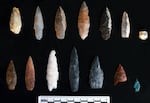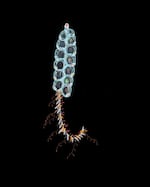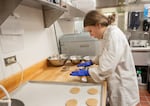In this monthly rundown from OPB, “All Science. No Fiction.” creator Jes Burns features the most interesting, wondrous and hopeful science coming out of the Pacific Northwest.
And remember: Science builds on the science that came before. No one study tells the whole story.
Getting to the point

Stone projectile points discovered buried inside and outside of pit features at the Cooper’s Ferry site.
Loren Davis / Oregon State University
For decades, scientists have debated when humans first crossed from Asia to North America. And for a long time, 13,500 years ago was the date — that’s when the Bering Land Bridge between what’s now Alaska and Russia was exposed.
But more recently, archeological discoveries have pushed that first-arrival date way back. Researchers from Oregon State University are adding to the evidence of an earlier migration.
They’ve dated 14 projectile points (similar to arrowheads) found at an early-human site on traditional Nez Perce land in Idaho to nearly 15,800 years ago. They’re the oldest points ever found in the Americas.
And not only are the artifacts old, they’re very similar in style to points uncovered in Japan from 16,000-20,000 years ago, meaning the first Americans may have been genetically and culturally connected to those groups.
Read the paper from the journal Science Advances here.
Mmmm … sleep
Unscientifically speaking, desire for more and better sleep is pretty much a modern-day human universal. Who doesn’t want more good sleep?
Scientifically speaking, researchers at the University of Washington are studying how to make that happen. The scientists tracked the sleep schedules of about 500 UW students and found they went to bed later during the dark winter months than in summer when there’s much more daylight.
The scientists believe the cause has to do with light exposure — and what time of day that exposure happens. The data showed that every hour of light exposure in the morning pulled the students’ circadian cycle (when your body naturally wants to sleep) up 30 minutes. An hour of evening light exposure pushed it back by 15 minutes. The researchers concluded something we could all maybe take a pro-tip from: In the winter, the students just weren’t getting enough early-day light exposure, making them naturally want to go to sleep later.
Read the paper from the Journal of Pineal Research here.
Jellies on the go

In this photo released by the University of Oregon, Nanomia bijuga, a marine animal related to jellyfish, swims via jet propulsion.
University of Oregon
Scientists often look to biology to solve engineering problems. And why not? Plants and animals have had millions of years of evolution behind them to get it right.
Researchers at the University of Oregon are taking their inspiration from a tiny jellyfish-like creature called Nanomia bijuga, which has a really cool way of getting around. The jelly uses jet propulsion that’s created when squishy structures called nectophores contract and undulate, propelling them forward. They can move them all at the same time or in sequence, depending on whether they’re trying to escape from a predator or just out for a leisurely swim.
It might not sound like a big deal, but these nectophores allow the jellies to achieve speed and efficient motion — something that’s actually pretty rare. And the scientists say this model could be used when designing underwater vehicles to achieve the best of both worlds.
Read the paper from the journal Proceedings of the National Academy of Sciences here.
They believe the forests are our future
Standing forests do a lot for us in the Pacific Northwest. They preserve drinking water quality and biodiversity and act as one of the greatest carbon sinks in the Western United States.
Researchers connected to the Conservation Biology Institute in Corvallis have created a manual of sorts for Oregon to meet international biodiversity and climate goals (protecting 50% of forestland by 2050). According to the scientists’ calculations, Oregon currently has less than 10% of its forestlands protected to the highest international standards.
The scientists have created maps that ID the highest priority forestland for protection to get the most bang for our buck. The framework can be applied in other parts of the world, and comes at a critical time for the planet in the face of climate change.
Read the paper from the journal Frontiers in Forests and Global Change here.

In this photo released by Washington State University, food science graduate student Elizabeth Nalbandian prepares cookie dough containing quinoa flour for baking.
Washington State University
Making a better cookie
Quinoa is one of those so-called “superfoods” that’s so-far avoided fading into annals of fad food. The South American grain is high in protein and fiber and there are more than 120 varieties.
Researchers at Washington State University are breeding new lines of quinoa specifically suited to grow in the Pacific Northwest. They recently put 10 of those lines through taste tests to figure out which performed best in different types of food.
Turns out, sugar cookies made with a little quinoa flour are kind of delicious. In preliminary results, taste testers liked the cookies that used 25% quinoa flour, but as the amount went higher, the cookie’s texture suffered. The investigation suggested that 10% quinoa sugar cookies actually fared better than full-flour because the grain added a nutty flavor.
The Washington researchers are working to bring quinoa more into the mainstream and expand the farming possibilities in the state.
Read the paper from the Journal of Food Science here.
Watch more videos from “All Science. No Fiction.” on the science of sleep, a drone that can smell things and how solar panels can help sheep and the farmers who raise them. And learn more about how the show is made from creator Jes Burns and videographer Brandon Swanson at a live Science on Tap event Jan. 26 at Kiggins Theatre, 1011 Main St., in Vancouver, Wash.
